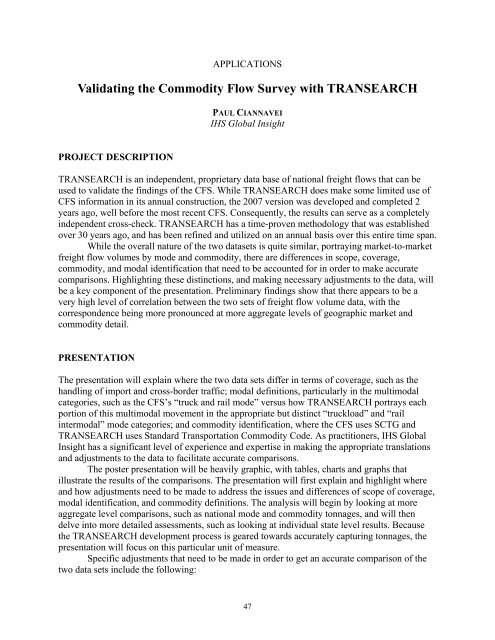E-C158 Cover1 - Center for Transportation Analysis - Oak Ridge ...
E-C158 Cover1 - Center for Transportation Analysis - Oak Ridge ...
E-C158 Cover1 - Center for Transportation Analysis - Oak Ridge ...
Create successful ePaper yourself
Turn your PDF publications into a flip-book with our unique Google optimized e-Paper software.
APPLICATIONS<br />
Validating the Commodity Flow Survey with TRANSEARCH<br />
PROJECT DESCRIPTION<br />
PAUL CIANNAVEI<br />
IHS Global Insight<br />
TRANSEARCH is an independent, proprietary data base of national freight flows that can be<br />
used to validate the findings of the CFS. While TRANSEARCH does make some limited use of<br />
CFS in<strong>for</strong>mation in its annual construction, the 2007 version was developed and completed 2<br />
years ago, well be<strong>for</strong>e the most recent CFS. Consequently, the results can serve as a completely<br />
independent cross-check. TRANSEARCH has a time-proven methodology that was established<br />
over 30 years ago, and has been refined and utilized on an annual basis over this entire time span.<br />
While the overall nature of the two datasets is quite similar, portraying market-to-market<br />
freight flow volumes by mode and commodity, there are differences in scope, coverage,<br />
commodity, and modal identification that need to be accounted <strong>for</strong> in order to make accurate<br />
comparisons. Highlighting these distinctions, and making necessary adjustments to the data, will<br />
be a key component of the presentation. Preliminary findings show that there appears to be a<br />
very high level of correlation between the two sets of freight flow volume data, with the<br />
correspondence being more pronounced at more aggregate levels of geographic market and<br />
commodity detail.<br />
PRESENTATION<br />
The presentation will explain where the two data sets differ in terms of coverage, such as the<br />
handling of import and cross-border traffic; modal definitions, particularly in the multimodal<br />
categories, such as the CFS’s “truck and rail mode” versus how TRANSEARCH portrays each<br />
portion of this multimodal movement in the appropriate but distinct “truckload” and “rail<br />
intermodal” mode categories; and commodity identification, where the CFS uses SCTG and<br />
TRANSEARCH uses Standard <strong>Transportation</strong> Commodity Code. As practitioners, IHS Global<br />
Insight has a significant level of experience and expertise in making the appropriate translations<br />
and adjustments to the data to facilitate accurate comparisons.<br />
The poster presentation will be heavily graphic, with tables, charts and graphs that<br />
illustrate the results of the comparisons. The presentation will first explain and highlight where<br />
and how adjustments need to be made to address the issues and differences of scope of coverage,<br />
modal identification, and commodity definitions. The analysis will begin by looking at more<br />
aggregate level comparisons, such as national mode and commodity tonnages, and will then<br />
delve into more detailed assessments, such as looking at individual state level results. Because<br />
the TRANSEARCH development process is geared towards accurately capturing tonnages, the<br />
presentation will focus on this particular unit of measure.<br />
Specific adjustments that need to be made in order to get an accurate comparison of the<br />
two data sets include the following:<br />
47

















